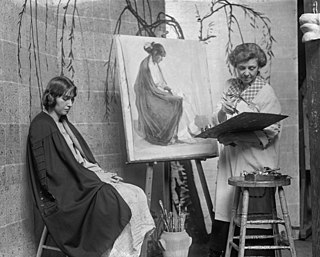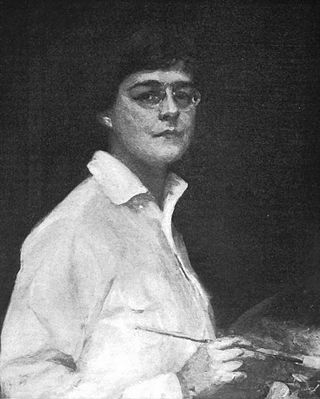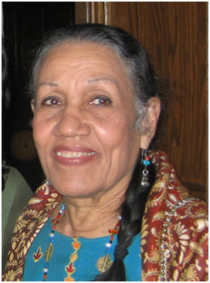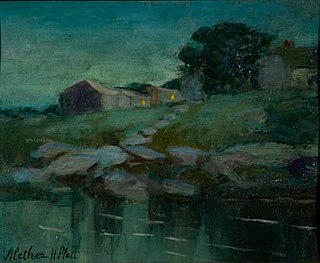Related Research Articles

There are many outdoor sculptures in Washington, D.C. In addition to the capital's most famous monuments and memorials, many figures recognized as national heroes have been posthumously awarded with his or her own statue in a park or public square. Some figures appear on several statues: Abraham Lincoln, for example, has at least three likenesses, including those at the Lincoln Memorial, in Lincoln Park, and the old Superior Court of the District of Columbia. A number of international figures, such as Mohandas Gandhi, have also been immortalized with statues. The Statue of Freedom is a 19½-foot tall allegorical statue that rests atop the United States Capitol dome.
Florence Elizabeth Riefle Bahr was an American artist and activist. She made portraits of children and adults, including studies of nature as she found it. Instead of using a camera, more than 300 pen and ink sketchbooks catalog insights into her life, including her civil and human rights activism of the 1960s and 1970s. One of the many important captured events included the Washington D.C. event where Martin Luther King Jr. first gave his I Have a Dream speech. Her painting Homage to Martin Luther King hangs in the (NAACP) National Association for the Advancement of Colored People's headquarters. She created illustrations for children's books and painted a mural in the Works Progress Administration (WPA) for the Johns Hopkins Hospital's Harriet Lane Home for Children. Her works have been exhibited in solo and group exhibitions since the 1930s. In 1999, she was posthumously awarded to the State of Maryland's Women's Hall of Fame, as the first woman artist they recognized.

The Sixteenth Street Historic District is a 1.25-mile (2.01 km) linear historic district in Washington, D.C., that includes all structures along 16th Street NW between H Street and Florida Avenue. The district's southern boundary is bordered by Lafayette Square, just north of the White House, and Meridian Hill Park on its northern boundary. It includes an eclectic mix of architectural styles on one of the city's most historic and important numbered streets including single and multi-family residential buildings, embassies, hotels, churches, and office buildings.

Joan of Arc is a 1922 cast of Paul Dubois's 1889 statue of Joan of Arc, located at Meridian Hill Park in Washington, D.C., United States of America. Joan of Arc was originally surveyed as part of the Smithsonian's Save Outdoor Sculpture! survey in 1994.

Jennie Augusta Brownscombe was an American painter, designer, etcher, commercial artist, and illustrator. Brownscombe studied art for years in the United States and in Paris. She was a founding member, student and teacher at the Art Students League of New York. She made genre paintings, including revolutionary and colonial American history, most notably The First Thanksgiving held at Pilgrim Hall in Plymouth, Massachusetts. She sold the reproduction rights to more than 100 paintings, and images of her work have appeared on prints, calendars and greeting cards. Her works are in many public collections and museums. In 1899 she was described by New York World as "one of America's best artists."

The Lenthall Houses are historic houses on the George Washington University campus in Washington, D.C. The adjacent houses were built around 1800 and they were moved to their current location and restored between 1978 and 1979. It has been listed on the District of Columbia Inventory of Historic Sites since 1964 and it was listed on the National Register of Historic Places in 1972.

Nina Evans Allender was an American artist, cartoonist, and women's rights activist. She studied art in the United States and Europe with William Merritt Chase and Robert Henri. Allender worked as an organizer, speaker, and campaigner for women's suffrage and was the "official cartoonist" for the National Woman's Party's publications, creating what became known as the "Allender Girl."

Marion Boyd Allen was an American painter, known for her portraits and landscapes.

CatharineCarter Critcher was an American painter. A native of Westmoreland County, Virginia, she worked in Paris and Washington, D.C. before becoming, in 1924, a member of the Taos Society of Artists, the only woman ever elected to that body. She was a long time member of the Arts Club of Washington.

Harriet Blackstone was an American figure and portrait painter. Many of her subjects were midwestern business leaders and their families she also painted a number of prominent musicians.
Mathilde Mueden Leisenring (1870–1949) was an American painter, mainly of portraits.
Yvonne Pickering Carter is an American painter, performance artist, and educator. She has worked in media including watercolor and collage.

Christine Herter Kendall was an American painter.
Helen Alton Sawyer (1900–1999) was an American painter.
Lilian Thomas Burwell is a Washington, DC sculptor and painter whose shaped paintings often blur the line between the two disciplines. Her artwork uses abstraction to create a personal response to the natural world.

Georgia Mills Jessup was an American painter, sculptor, ceramicist, muralist, and collage artist.
Clara Lavinia Hill was an American sculptor.
Susan Brown Chase (1868–1948) was an American painter.

Alethea Hill Platt was an American artist and educator. Her paintings of rural landscapes in France, England, the Adirondacks, and New England were displayed in about 200 exhibitions at venues including the National Academy of Design, Pennsylvania Academy of the Fine Arts, and Louisiana Purchase Exposition. The New York Times found a "quality of serenity, even a kind of nobility" in her work, and American Art News placed her "in the ranks of America's leading women painters."
Irene Weir, was an American artist and art educator.
References
- ↑ Jules Heller; Nancy G. Heller (19 December 2013). North American Women Artists of the Twentieth Century: A Biographical Dictionary. Taylor & Francis. pp. 2298–. ISBN 978-1-135-63889-4.
- 1 2 Kelly, John (14 June 2013). "Where, oh where is Meridian Hill Park's armillary sphere?". Washington Post . Archived from the original on 2 February 2017. Retrieved 23 January 2017.
- ↑ "Lenthall Houses". National Register of Historic Places. Retrieved 2012-03-21.
- ↑ "InTowner Publishing Corp. » The Lenthall Houses: A Moving Tale of Historic Preservation?" . Retrieved 23 January 2017.
- ↑ "The Noyes Armillary Sphere Described In The Historic American Buildings Survey #532 // The Daily Render by Nikolas R. Schiller". 9 February 2010. Retrieved 23 January 2017.
- ↑ interment.net